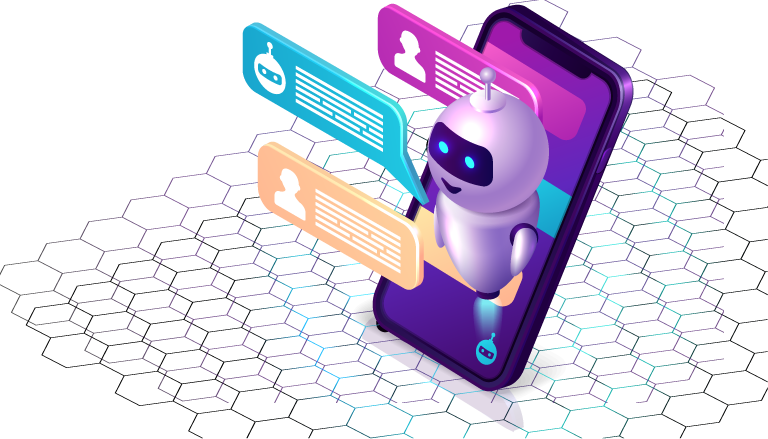Chatbots are built to automatically engage with incoming messages. Chatbots are often programmed to reply an equivalent way whenever, to reply differently to messages containing certain keywords, and even to use machine learning to adapt their responses to fit the situation.
Chatbots leverage chat mediums like SMS text, website chat windows, and social messaging services across platforms like Facebook and Twitter to receive and answer messages.
Chatbots come in all forms. There are some fun and goofy chatbots like Cleverbot, a chatbot that chats with real people and learns as it goes.
How does chatbot look and work
Chatbots interpret and process user’s words or phrases and provides a moment pre-set answer.
There are three main types of chatbots:
- Rule-based chatbots
This is the simplest type of chatbot today. Usually, a user interacts by using predefined options. This type of chatbot requires the user to form a couple of selections therefore the bot could provide a better and more relevant answer. Due to that, this type of bots has a longer user journey, and they are the slowest to guide the customer to the desired goal.
These bots are great when it involves answering basic customer support issues your customer address the foremost. The chatbot — asks questions, and therefore the user answers them with buttons. Based on that, the chatbot sums up the collected info and provides a reply. But, when it comes to more advanced scenarios with many conditions or factors, these chatbots aren’t always the best solution.
- Intellectually Independent Chatbots
These bots are supported by Machine Learning which helps the system, in our case a chatbot, learn from user’s inputs and requests.
Long story short, these chatbots are trained to know certain keywords and phrases that trigger bot’s reply. These trigger phrases also can be combined with buttons and menus that make it even easier for a user to interact with a bot.
For example, you write to a chatbot: “I have a drag with logging into my account”. The bot would understand the words “problem” “logging” “account” and would offer a predefined answer supported these phrases.
- AI-powered chatbots
This type of chatbot is the most advanced. It uses machine learning and AI (Artificial Intelligence) to recollect the context of the conversation and user preferences. These bots can jump from one point of predefined conversation scenario to a different when needed and address random user requests at any moment of interaction.
Let’s imagine you are talking to Alera, an AI-powered chatbot-lawyer, to create a Will. Alera would ask you a set of questions to collect the information needed to create a document. At some point, you’ll encounter an unknown legal term for instance “beneficiary”. You can ask Alera “What is a beneficiary?” and it would give you an instant reply and then get back to filling out your Will from the point where you stopped. After collecting the required data, the chatbot would process the knowledge, create a document, and store it within the conversation, where a user can download it.
Chatbots are faster, cheaper and easier to develop
Another great advantage of chatbots is that they’re much easier, faster, and cheaper to develop.
Launching a chatbot comparing to apps is quicker because the messaging app, where your chatbot goes to be is already built. All you would like is to develop a chatbot which is far less complex than developing an app.
Over the past few years, tons of various chatbot building platforms were created. These platforms are friendly for people without coding knowledge. Using these platforms, you’ll create simple chatbots that will perform and answer basic user requests. If you are unaware of the functionality, tongue Processing( NLP), or don’t have time to develop a chatbot yourself, there are professionals who would develop for you. And usually, it still would be less expensive than app development.
During this transitional phase, business owners need to understand that poorly executed chatbot protocols can still fall short and offer a poor customer experience.
Brands should specialize in implementing chatbots in a way that simplifies existing processes instead of going for the fanciest promises.
Offer guidance to customers set expectations and teach customers to interact with chatbots during a way that’s ultimately beneficial to the expansion of your brand.
Here’s how a chatbot enhances customer experiences:
- Seamless live chat
- 24/7 customer service
- Endless queries, zero chance of sass
- A smoother journey
- Less stress
- Goodbye, IVR
- Personify your brand
- Reinvent your forms
Chatbots are quite the “wave of the future” in customer service. They are in the “here and now,” allowing vendors more opportunities to engage with customers in new and different ways — and more importantly, to fulfill their goals more efficiently.
As David Cancel told us, he is not interested by customers thinking, he needs chatbot to think like a human.
When a chatbot is “good at what it does,” then the customer walks away with a far better experience for having used it.
Looking Forward: One Bot to Rule Them All?
Chatbots have a long way to go before they realize their full potential. Along, with billions of dollars of annual investment and significant human capital committed to their development, chatbots will generate significant future value in both the corporate and consumer sectors.
Many open questions remain. How might personalized chatbots manifest going forward? Further, many companies are striving to develop the most advanced chatbot for both consumers and enterprises. In the race to develop the simplest chatbot, will one company or product truly emerge above the rest? While many chatbots may prove viable, industry consolidation may cause one dominant product. However, the chatbot industry develops, what’s clear is that it will only become more consequential in how businesses and consumers interact.

